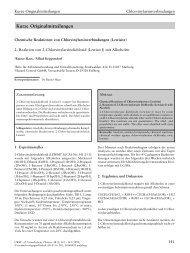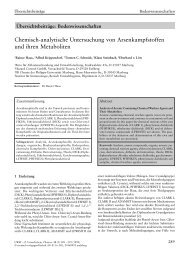Determination of Chemical Warfare Agents - Dr. Rainer Haas
Determination of Chemical Warfare Agents - Dr. Rainer Haas
Determination of Chemical Warfare Agents - Dr. Rainer Haas
You also want an ePaper? Increase the reach of your titles
YUMPU automatically turns print PDFs into web optimized ePapers that Google loves.
Short Original Communications <strong>Chemical</strong> <strong>Warfare</strong> <strong>Agents</strong><br />
Short Original Communications<br />
<strong>Determination</strong> <strong>of</strong> <strong>Chemical</strong> <strong>Warfare</strong> <strong>Agents</strong><br />
Gas Chromatographic Analysis <strong>of</strong> Ethylarsine Dichloride by Derivatization with Dithiols<br />
(3rd Communication)<br />
<strong>Rainer</strong> <strong>Haas</strong><br />
Corresponding address: <strong>Dr</strong>. <strong>Rainer</strong> <strong>Haas</strong>, Büro für Altlastenerkundung und Umweltforschung, Stadtwaldstr. 45a,<br />
D-35037 Marburg, Germany<br />
Abstract<br />
Ethylarsine dichloride was used during WW I as a chemical warfare<br />
agent. Residues <strong>of</strong> this chemical warfare agent and its<br />
metabolites are still present today and continue to contaminate<br />
soil and water.<br />
A gas chromatographic method for the detection and determination<br />
<strong>of</strong> ethylarsine dichloride is shown. Six dithiols were tested<br />
as possible derivatization reagents for ethylarsine dichloride.<br />
With selection <strong>of</strong> the dithiol, matrix interferences can be eliminated<br />
because <strong>of</strong> the different retention times <strong>of</strong> the derivatives.<br />
Keywords: Analysis; arsenic compounds; chemical warfare<br />
agents; cwa; derivatization; detection; determination; ethylarsine<br />
dichloride; gas chromatography<br />
1 Experimental<br />
Ethylarsine dichloride [CAS-No.: 598-14-1] was produced<br />
in WW I as a chemical warfare agent. Ethylarsine dichloride<br />
can be detected with GC/ECD without derivatization. It reacts<br />
with dithiols by forming cyclic derivatives that can be<br />
detected with GC/ECD as well.<br />
Derivatizations with dithiols are performed with 1,2-ethane<br />
dithiol [Et(SH) 2 ], 1,3-propane dithiol [Pr(SH) 2 ], 1,4-butane<br />
dithiol [Bu(SH) 2 ], 1,5-pentane dithiol [Pe(SH) 2 ], 1,6-hexane<br />
dithiol [He(SH) 2 ] and 1,8-octane dithiol [Oc(SH) 2 ].<br />
For the derivatization, 20 µl <strong>of</strong> an acetonic dithiol solution<br />
[c = 100 g/l] and 20 µl <strong>of</strong> an acetonic ethylarsine dichloride<br />
solution [c = 6.8 g/l] is added to 500 µl acetone in 1.4 mlvials<br />
(reaction time: 15 min; T = 20°C).<br />
For the separation <strong>of</strong> ethylarsine dichloride and its dithiol<br />
derivatives, an HP 5890 gas chromatograph with HP 7673<br />
autosampler and electon capture detector (ECD) was used.<br />
The temperatures <strong>of</strong> the injector block and the detector were<br />
250°C and 300°C, respectively. The injection volume was<br />
1 µl (split injection). A DB 5 column, 30 m, 0.25 mm i.d.,<br />
0.25 mm d f was used. The carrier gas was nitrogen (head<br />
pressure 100 kPa). The column temperature was started at<br />
100°C (1 min), was raised with 10°C/min to 230°C and<br />
then held for another 6 min.<br />
2 Results and Discussion<br />
Ethylarsine dichloride reacts with dithiols in a substitution<br />
reaction by forming cyclic compounds:<br />
EtAsCl + R(SH) → EtAsS R + 2 HCl.<br />
2 2 2<br />
The derivatization is completed in 15 min at a temperature<br />
<strong>of</strong> 20°C. The cyclic derivatives are stable. The derivatives<br />
can be detected with GC/ECD. They were identified with<br />
mass spectrometry. In Table 1, the retention times and the<br />
limits <strong>of</strong> detection <strong>of</strong> ethylarsine dichloride and its dithiol<br />
derivatives is shown.<br />
Table 1: Retention times (t R ) and limits <strong>of</strong> detection (LOD) <strong>of</strong><br />
ethylarsine dichloride and its dithiol derivatives; for GC conditions<br />
see experimental data<br />
thiol derivative t /min R LOD/ng<br />
--- EtAsCl2 2.84 3.5<br />
Et(SH) 2 EtAsS Et 2 3.88 1.3<br />
Pr(SH) 2 EtAsS Pr 2 5.48 3.5<br />
Bu(SH) 2 EtAsS Bu 2 7.49 3.5<br />
Pe(SH) 2 EtAsS Pe 2 12.26 3.5<br />
He(SH) 2 EtAsS He 2 13.33 3.5<br />
Oc(SH) 2 EtAsS Oc 2 15.77 1.7<br />
ESPR – Environ. Sci. & Pollut. Res. 5 5 (2) 1998 63 – 64 (1998)<br />
63<br />
© ecomed publishers, D-86899 Landsberg, Germany
<strong>Chemical</strong> <strong>Warfare</strong> <strong>Agents</strong> Short Original Communications<br />
The reaction <strong>of</strong> ethylarsine dichloride with the six tested<br />
dithiols is quantitative. After derivatization, no ethylarsine<br />
dichloride can be detected with GC/ECD.<br />
Through the use <strong>of</strong> 1:1 molar mixtures <strong>of</strong> two dithiols, different<br />
rates <strong>of</strong> the possible derivatives are built. These rates<br />
present the thermodynamic stability <strong>of</strong> the cyclic ethylarsine<br />
dithiol derivatives. The most stable products are the derivatives<br />
<strong>of</strong> ethylarsine dichloride with 1,2-ethane dithiol and<br />
1,3-propane dithiol. The same effect was shown for the<br />
derivatization <strong>of</strong> phenylarsine dichloride (PFIFFIKUS) and<br />
2-chlorovinylarsine dichloride (LEWISITE I) with dithiols<br />
[1,2]. All <strong>of</strong> these arsenic containing chemical warfare agents<br />
are able to form cyclic derivatives. The results are shown in<br />
Table 2.<br />
Table 2: Rate <strong>of</strong> ethylarsine dithiol derivatives by using equimolar<br />
mixtures <strong>of</strong> two dithiols<br />
thiol 1 thiol 2 derivative 1<br />
%<br />
Et(SH) 2 Pr(SH) 2 97 3<br />
Et(SH) 2 Bu(SH) 2 99 1<br />
Et(SH) 2 Pe(SH) 2 97 3<br />
Et(SH) 2 He(SH) 2 97 3<br />
derivative 2<br />
%<br />
Et(SH) 2 Oc(SH) 2 99.5 0.5<br />
Pr(SH) 2 Bu(SH) 2 87 13<br />
Pr(SH) 2 Pe(SH) 2 100 0<br />
Pr(SH) 2 He(SH) 2 67 33<br />
Pr(SH) 2 Oc(SH) 2 81 19<br />
Bu(SH) 2 Pe(SH) 2 25 75<br />
Bu(SH) 2 He(SH) 2 29 71<br />
Bu(SH) 2 Oc(SH) 2 36 64<br />
Pe(SH) 2 He(SH) 2 56 44<br />
Pe(SH) 2 Oc(SH) 2 51 49<br />
He(SH) 2 Oc(SH) 2 39 61<br />
The derivatization procedure is quick and easy and the analysis<br />
is highly selective. The limits <strong>of</strong> detection differ between<br />
1.3 ng and 3.5 ng. By choosing an appropriate dithiol, matrix<br />
interferences can be eliminated because <strong>of</strong> the different<br />
retention times <strong>of</strong> the resulting ethylarsine derivatives.<br />
This derivatization reaction can be used for the gas chromatographic<br />
detection and determination <strong>of</strong> ethylarsine<br />
dichloride in contaminated water and soil samples together<br />
with other arsenic containing chemical warfare agents, e.g.<br />
diphenylarsine chloride (CLARK I), phenylarsine dichloride<br />
(PFIFFIKUS), 2-chlorovinylarsine dichloride (LEWISITE I)<br />
and 2,2'-dichlorodivinylarsine chloride (LEWISITE II)<br />
[1,2,3,4].<br />
Figure 1 shows the overlayed gas chromatograms <strong>of</strong> five<br />
cyclic ethylarsine dithiole derivates.<br />
64 ESPR – Environ. Sci. & Pollut. Res. 5 (2) 1998<br />
SH<br />
1<br />
2<br />
3<br />
4<br />
4 6 8 10<br />
5<br />
t/min<br />
Fig. 1: Overlayed gas chromatograms <strong>of</strong> ethylarsine dichloride derivatives<br />
(68 ng) with Pr(SH) 2 [1]; Bu(SH) 2 [2], Pe(SH) 2 [3], He(SH) 2<br />
and Oc(SH) 2 ; GC conditions see experimental data; column temperature:<br />
210°C isotherm<br />
3 References<br />
[1] HAAS, R.; SCHMIDT, T.C. (1997): Chemische Reaktionen von<br />
Phenylarsinverbindungen. 3. Reaktion von Phenyl-Arsen-Verbindungen<br />
mit Dithiolen. UWSF – Z. Umweltchem. Ökotox. 9<br />
(1997), 183-184<br />
[2] HAAS, R. (1998): Chemische Reaktionen von Chlorvinylarsinverbindungen<br />
(Lewisite). 3. Reaktion von Lewisit I und Lewisit<br />
II mit Dithiolen. UWSF-Z. Umweltchem. Ökotox. in print<br />
[3] HAAS, R. (1997): Chemische Reaktionen von Phenylarsinverbindungen.<br />
2. Reaktion von Diphenylarsinverbindungen mit<br />
Dithiolen. UWSF – Z. Umweltchem. Ökotox. 9 (1997), 123-<br />
124<br />
[4] HAAS, R.; SCHMIDT, T.C.; STEINBACH, K.; V. LÖW, E. (1997):<br />
Gaschromatographische Bestimmung von Arsenkampfst<strong>of</strong>fen<br />
und Umwandlungsprodukten. Fachtagung Rüstungsaltlasten<br />
(Grundwassersanierung), Munster 7./8.10.97<br />
Received: October 24th, 1997<br />
Accepted: February 23rd, 1998





